 |
Conducting Meetings: Conflicts, Climates, and Difficult Personalities |
0.50 |
In this course you will learn to: identify the main causes of conflict, the ways to resolve conflict in meetings, and the common difficult personality types in meetings, and identify the characteristics of a positive and negative climate, and the steps to build a positive climate when communicating. |
 |
Conducting Meetings: Fundamentals of Conducting Meetings |
0.67 |
Meetings allow groups to function, define goals, contribute to participants’ morale and status, as well as develop organizational culture. During meetings, participants are able to exchange information and update one another on current events. When information is shared among participants, they are able to work together to create ideas and solutions, and make decisions to progress toward the group’s goals.
In order for a group to function effectively, participants must be working toward accomplishing a common goal. Meetings allow participants to define goals as a group, which helps them agree on the terms of the goals, such as how and when they’ll be accomplished.
When the meeting leader encourages input from participants, employee morale increases. Encouraging communication satisfies the participants’ desire to play an active role in the organization. When participants understand that their opinions are valued, they feel that they’ve contributed to their organization.
Meetings also help develop the organization’s culture when meeting leaders demonstrate the values and attitudes preferred by the organization. Leaders display organizational values in meetings to reinforce the behavior they desire from participants.
In this course you will learn to: identify the benefits, types and misconceptions about meetings, plan a meeting, participate in a meeting, and close a meeting. |
 |
Conducting Meetings: Listening Effectively and Asking Questions |
0.50 |
To communicate effectively during a meeting, you have to listen and ask appropriate questions. Listening and questioning are two interdependent skills that will help you create a positive climate, develop positive dialog, and achieve the group’s goals.
By listening and questioning effectively, you’ll actively engage yourself and others in the meeting. Actively participating will enable you to quickly identify and address other participants’ thoughts, ideas, and concerns. Facilitating communication in this manner will foster individual and group success.
In this course you will learn to: identify the main causes of conflict, the ways to resolve conflict in meetings, and the common difficult personality types in meetings, and identify the characteristics of a positive and negative climate, and the steps to build a positive climate when communicating. |
 |
Conducting Meetings: Managing Meetings |
0.67 |
In this course you will learn to: identify the types of meeting leaders and the characteristics of an effective meeting leader. identify the process to follow when making decisions in a meeting, and explain how to identify and minimize group think in meetings. |
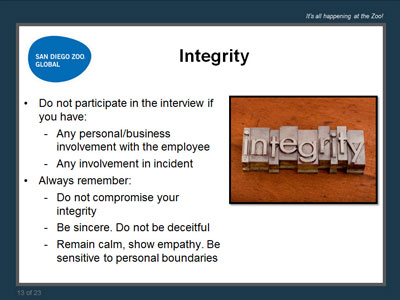 |
Conducting World Class Employee Investigations |
1.00 |
Employment litigation and claims in recent years have cost employers billions of dollars. Employers must find ways to reduce their vulnerability to such claims. Often times, employer liability hinges on the quality of the company's investigation into complaints of discrimination, harassment, or other claims of workplace misconduct. In fact, an important consideration in an employee's decision to ultimately file a lawsuit or claim is whether the employer conducted an effective workplace investigation. Join San Diego Zoo Global's Associate Director of Human Resources for a dynamic and informative workshop on how to conduct effective workplace investigations that will protect your organization and reduce potential litigation costs. This comprehensive webinar will include a discussion about:
- A step-by-step approach on how to plan and conduct workplace investigations
- A practical demonstration of effective interview techniques
- How to anticipate and respond to legal and practical issues that frequently arise during the course of investigations
- Preparing bullet-proof documentation to support the investigation findings and recommended actions |
 |
Correcting Performance Problems: Addressing Behavioral Problems |
0.84 |
In this course you will learn to: communicate and prevent the discrepancy between an employee’s behavior and performance standards, and identify the type of employee reaction and tackle it effectively.
For a feedback session to be effective, you need to emphasize the impact of the problem behavior to the employee. Their behavior mainly impacts three entities: the organization, co-workers, and the employee. When explaining these factors, you should maintain a proper perspective based on some set guidelines throughout the feedback. |
 |
Correcting Performance Problems: Disciplining Employees |
1.67 |
Discipline is proactive, as opposed to punishment, which is reactive. Punishment provides a consequence to an action that is deemed unacceptable, whereas discipline is designed to exchange undesirable behavior for satisfactory behavior.
The purpose of disciplining an employee is twofold:
1. To correct or eliminate undesirable behavior, and
2. To provide training that improves or strengthens performance.
In this course you will learn to: keep a disciplinary perspective, determine the cause for disciplining an employee, and prepare for conducting a disciplinary meeting, maintain a positive rapport, avoid pitfalls during a disciplinary meeting with employees, and keep meetings productive, and monitor employee performance and conduct a follow-up meeting with the employee. |
 |
Correcting Performance Problems: Identifying Performance Problems |
1.50 |
An attendance problem occurs when an employee fails to report to work, doesn’t give proper notification of an absence, or exceeds the number of days allotted for absence.
You should address attendance problems carefully. Handling these problems poorly can lead to serious consequences, such as frequent employee turnover or workplace aggression. Before confronting an employee with an attendance problem, you need to identify the type of attendance problem and determine its severity.
In this course you will learn to: identify the types of attendance problems, assess their impacts, and determine a problem’s severity, identify the types of achievement problems, assess their impacts, and determine a problem’s severity, identify the types of conduct problems, assess their impacts, and determine a problem’s severity. |
 |
Correcting Performance Problems: Investigating Performance Problems |
1.00 |
Before addressing a performance problem, you should confirm the existence of the problem itself. An interview is a useful method for doing this. During the interview, you might encounter facts that you were previously unaware of and excuses that you didn’t expect. It's important to follow a definite process, and expect the unexpected during the interview.
In this course you will learn to: identify the causes for an employee’s performance problem by interviewing, and question an employee regarding attendance issues, describe the factors affecting achievement, and apply conduct investigation techniques. |
 |
Correcting Performance Problems: Providing Feedback To Employees |
0.84 |
By addressing employees who have performance problems, you can help them make positive changes, encourage career advancement, and promote personal and professional growth. Addressing an employee involves providing the feedback necessary to improve performance.
In this course you will learn to: prepare to conduct a feedback session in which you encourage communication with the employee, and conduct a constructive feedback session with an employee who has a performance problem. |
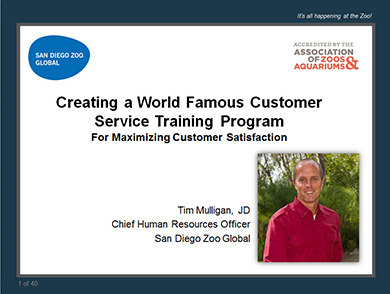 |
Creating a World Famous Customer Service Training Program |
1.00 |
Are you interested in putting together a unique, world class, and cost effective Customer Service Training Program, rather than just purchasing one "off the shelf?" This webinar will walk you through the steps taken by San Diego Zoo Global to create its GRRREAT! Customer Service Training Program - all done in house! |
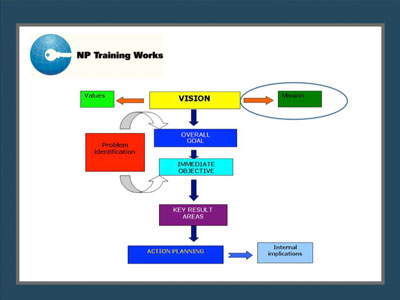 |
Creating and Implementing an Effective Strategic Plan for Your Organization |
1.00 |
Without strategic direction it is hard to get where you want the organization to go. This Webinar offers you a process for reaching your organizational goals. Strategic plans help your organization, or department, set the roadmap to make a significant mission impact. Through this Webinar you will learn a model for completing a Strategic Planning process in your organization. It covers the entire process from planning to defining the strategic framework and then creating a process for implementation activities. You will learn how to create a strategic framework that gives the activities coherence and direction, ensuring that your strategic plan becomes a living, breathing document that is fully utilized in the organization. You will also learn how to involve your board, staff, and other important constituencies in the process to increase your chances of successful implementation. In addition, you will receive leave-behinds that give you practical exercises and instructions to use during your strategic planning process. |
 |
Creativity and Innovation: Creative Thinking Basics |
1.34 |
Creativity is the ability to imagine new concepts or combine existing ideas in new and different ways. An old idea that was not applicable in the past might become practical if the factors that made it irrelevant have changed. These changes could be in the details of the idea, or in the situation in which it is to be applied.
Creativity is a key factor in personal development. There are certain traits that are evident in creative thinkers. To be creative, you need to differentiate between the traits that enhance your creativity, and those that inhibit it.
In this course you will: prepare yourself mentally and physically to be creative, use your experiences, innocence, intuition, and sense of adventure to increase your creativity. |
 |
Creativity and Innovation: Creativity In Organizations |
1.34 |
Creativity in an organization depends on various factors, such as the distribution of authority, the flow of information, and the culture. Some organizations encourage creative thinking to a large extent, and others discourage it. You can recognize a creative organization from its leaders. A leader who can influence a team and inspire them to work creatively builds a creative workforce. Such teams look at problem solving as a means to develop creativity. Although there are certain organizational situations that can enhance creativity, you should also be aware of the organizational factors and job conditions that can inhibit your creativity.
In this course you will learn to: develop creativity in an organization, and use creativity to generate ideas and solve problems. |
 |
Creativity and Innovation: Fostering A Creative Environment |
1.00 |
Creativity is the ability to look at a situation from every possible angle and determine potential ideas, solutions, or outcomes. Employees with this ability add value to an organization by increasing its efficiency and productivity. This is why board members, stockholders, managers, and other employees want to recruit and retain creative individuals. Everyone in an organization benefits from the recruitment of creative people.
When a candidate begins to search for a job or becomes aware of available positions, the candidate will form an opinion about your company based on promotional material, media articles, stories, and word-of-mouth. Creative people look for flexibility. Although managers might hire creative people, some managers still tend to stifle employees’ creativity with excessive rules and directions. Creative candidates must believe that they will have the flexibility to be innovative, or they will look elsewhere for employment.
In this course you will learn to: recruit and retain creative individuals, and maintain a creative environment. |
 |
Creativity and Innovation: Personal Creativity |
1.34 |
Creativity is often considered a talent that some people have. Actually, creativity's a skill that everyone can nurture through exercise and practice. You can prepare yourself both mentally and physically to be creative.
In this course you will learn to: prepare yourself mentally and physically to be creative, and use your experiences, innocence, intuition, and sense of adventure to increase your creativity. |
 |
Creativity and Innovation: Promoting Team Creativity |
1.34 |
The purpose of a team is to bring together people with diverse personalities, knowledge, education, and experience. This combined diversity encourages creativity and productivity to accomplish a common goal. Teams might consist of people from a single department or several departments.
Teams can generate new ideas, expand on or improve current ideas, make decisions, and solve problems. Teams can also be assigned to a specific task or be made responsible for a broader area, such as responding to changing customer expectations. When team members recognize their roles in a team, and the manager performs his responsibilities, creativity has a better chance of flourishing.
In this course you will learn to: identify characteristics of creative teams, and manage these teams effectively, conduct creative team sessions, and conduct brainstorming sessions, and use creativity to solve problems. |
 |
Cross-Cultural Business Communication: Addressing Cross-Cultural Issues |
1.00 |
When communicating with coworkers, it is very important to respect other cultures. You should refrain from using humor that might offend people from other cultures, and avoid stereotypes that might affect how you treat your coworkers.
Before communicating with employees who belong to a different culture, it is important to research their cultures and understand clearly what is expected from your communication. You should determine what types of communication are most appropriate in specific situations. For example, you should investigate the most appropriate method for communicating a behavioral problem to an employee. Some cultures prefer profuse praise to cushion the constructive feedback, while others prefer a more direct approach. The most important thing to communicate to employees of different cultures is respect. By approaching them in accordance with their cultural standards and expectations, you’ll show respect for their cultures and your communication will be enhanced.
In this course you will learn to: identify gestures used in different cultures and build a cross-cultural team, and discuss guidelines for writing cross-cultural documents and assembling a translation team. |
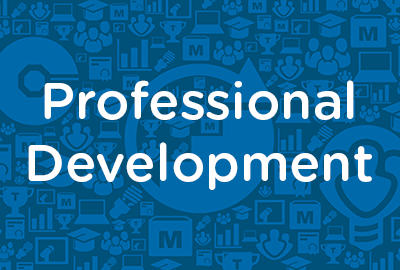 |
Cross-Cultural Business Communication: Communicating Across Cultures |
1.00 |
When communicating across cultures, you could come across a number of barriers. In addition to language barriers, there might be more subtle obstacles, such as cultural biases and conflicting communication styles. Building relationships with people of other cultures will provide you with the incentive to work through those barriers and achieve effective communication.
In this course you will learn to: establish rapport and build trust, and listen well and provide positive and constructive feedback. |
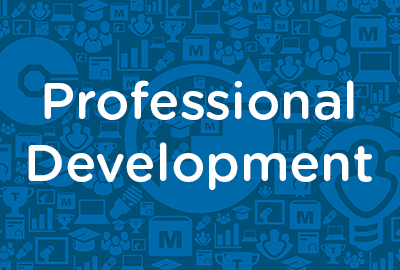 |
Cross-Cultural Business Communication: Cross-Cultural Business Situations |
1.00 |
You might be asked to attend or take part in cross-cultural meetings. Although cross-cultural meetings are common when you travel to a foreign country, they can also take place when several cultures send their representatives to attend meetings. These meetings might also take place over the telephone, online, or in a video conference.
In this course you will learn to: attend and organize cross-cultural meetings, conduct negotiations, and solve problems during a cross-cultural meeting. |
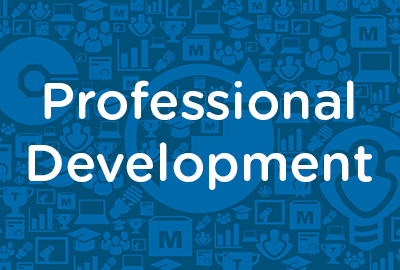 |
Cross-Cultural Business Communication: Differences In Communication |
1.00 |
When communicating with people of another culture, it is important to be aware of the person’s level of active participation in a conversation. In some cultures, highly active participation is the norm, while other cultures dictate a more passive involvement.
The exchange between people engaged in communication demonstrates conversational involvement. In any culture, a message must have both a sender and a receiver. In cultures with high conversational involvement, the receiver would send verbal and nonverbal cues, such as eye contact, nodding, and interjections, such as "I’m listening" or "Tell me more." In cultures with low conversational involvement, receivers would adopt a passive posture, perhaps staring at the ground with hunched shoulders, and would simply absorb the message without offering cues on whether they are listening or not.
In this course you will learn to: identify the differences in verbal communication across cultures, and improve your nonverbal communication skills by understanding the differences in gestures and expressions that vary across cultures. |
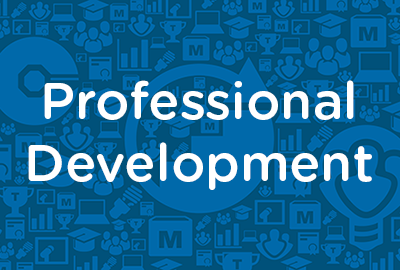 |
Cross-Cultural Business Communication: Overcoming Communication Barriers |
1.00 |
There are several barriers that can affect cross-cultural communication. Generally, barriers have a negative effect on communication because they might distort the speaker’s message or the listener’s understanding. It is important to understand these barriers to communicate effectively with people from different cultures.
In this course you will learn to: identify common cross-cultural communication barriers, overcome communication barriers and avoid cultural bias, and employ qualified interpreters and communicate through them. |
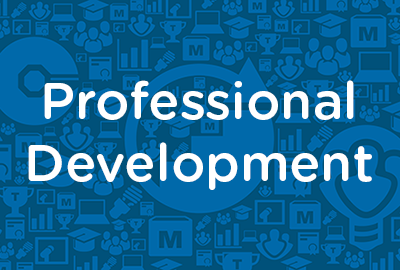 |
Cross-Cultural Business Communication: Workplace Culture |
1.00 |
Culture is a way of life established by a group of people and passed on to succeeding generations. People within a culture usually share common values, beliefs, and perspectives and have the same language and communication style. Although people within a culture must live in close proximity while the culture is being established, future generations frequently relocate to other countries or regions. This creates situations of cross-cultural exchanges.
As we become increasingly diverse, there is a growing demand for cross‑cultural communication in the workplace. Technology allows us to communicate with peers across the globe, as though they were sitting in our offices. Efficient and cost-effective travel makes it possible to communicate face-to-face with clients in other countries. In addition, companies seeking diverse and highly skilled employees find a conglomeration of cultures among them. As a result, employers are emphasizing cross-cultural communication in their own organizations to prepare employees to work with diverse co-workers and clients.
In this course you will learn to: discuss the value of culture and the significance of cross-cultural communication in the workplace, and describe the impact of cultural differences on communication, and avoid miscommunication and conflicts that arise due to these difference. |
 |
Cultural Competence |
0.33 |
Culture reflects belief systems, practices, and the products of beliefs and practices among groups of people. This Cultural Competence training course is designed for participants to engage, reflect, and apply the information provided. |
 |
Customer Communication |
1.00 |
In this course, you will learn about the importance of clear customer communication and effective listening. You’ll hear about some guidelines to help you communicate clearly, as well as the importance of non-verbal aspects of communication. You will learn how to provide good service on the telephone and will go through a three-step process for providing quality telephone service. You’ll also learn about telephone etiquette, including taking messages and how to effectively use voicemail. Finally, you’ll learn how to compose effective email messages. |


























